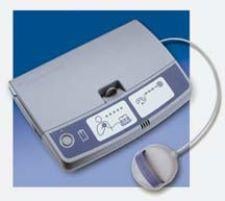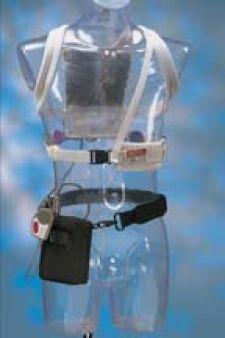
Patients use the Medtronic CareLink Monitor to transmit data from home to the physician via the Inte
One of the highest priorities for physicians who diagnose and treat heart failure conditions is to keep their patients stable and out of the hospital. To accomplish this, they choose from a wide variety of event monitoring devices that serve specific purposes and enable doctors to skillfully embark on a well-navigated journey of therapy.
A simplistic picture of the function of event monitoring outlines two basic device categories: 1. those used for diagnosis to help physicians pinpoint the cause of patient symptoms such as syncope or feelings of dizziness and lightheadedness; or 2. devices used to manage cardiac disease once a condition is known and defined. Goal No. 1 in the physician’s mind is to discover arrhythmias or other underlying causes quickly, then proactively treat and slow disease progression.
“A common problem is patients who have arrythmias, palpitations, skipped heartbeats or fast heartbeats, but they don’t have an implantable device,” said Heart Rhythm Society president Anne Curtis, M.D., director of the Division of Cardiology, professor of Medicine and CEO of Heart Services at the University of South Florida College of Medicine. “How do you monitor these? An important way is with event monitors that patients can just apply to their chest and then send [their data] over the telephone. Remote monitoring also has value for patients whom you think have rhythm problems and you want to see what is going on.”
Though certainly not new, event monitoring devices have broadened in available types in the market, and new technologies have moved these tools to sophisticated levels of remote cardiac data collection and transmission, which translates into solid information from which physicians make treatment determinations.
Important Advances
New scientific research and discovery about heart failure has helped device manufacturers refine their technologies, enabling clinicians to detect rhythm abnormalities early. Last year Medtronic introduced an impedance monitoring algorithm called OptiVol that measures fluid retention, which is a major marker of heart failure. OptiVol is currently available on Medtronic’s InSync Sentry implantable cardiac resynchronization therapy device and defibrillator (CRT-D) and provides automatic intrathoracic fluid status monitoring that measures, tracks and reports intrathoracic impedance.
“We’re looking at resistance to flow, or electricity within the body — as long as the resistance is high, that’s a good indication,” said Ven Manda, vice president of Cardiac Disease Management Marketing at Medtronic. “When resistance goes down, that means there is increased fluid build-up. OptiVol has changed the way physicians and clinicians manage heart failure, because now they are able to get a reliable assessment of a patient’s pulmonary fluid status, and with that change they can intervene and prescribe medications over the phone.”
The company anticipates FDA clearance this spring to use OptiVol with its Concerto CRT device, too.
On the data transmission front, Medtronic also announced FDA clearance in March to combine OptiVol impedance monitoring with its CareLink network, an Internet-based remote data collection system that provides a password-protected information bank to which patient cardiac data is automatically transferred, stored and then retrieved by clinicians for making therapy decisions. Manda says that nearly 62,000 patients are enrolled and monitored remotely through the CareLink system, and he indicates that a series of built-in checks and balances guard against transmission errors.
Medtronic’s next event monitoring device, called the Chronicle, is an intercardiac pressure monitoring tool that, Manda says, will offer physicians a more comprehensive picture of what’s occurring in the patient’s heart long before symptoms are exhibited. Intercardiac pressure is an important marker of worsening heart failure, he says — the company hopes to apply the Chronicle technology, which is under clinical study now, across the spectrum of its implantable devices.
“The idea behind disease management is not to pick one marker and say this is enough, but to [create] a comprehensive cardiac diagnostic dashboard in order to optimize the patient’s care,” said Manda.
Another future dimension of that dashboard is oxygen sensing, says Steve Szymkiewicz, M.D., vice president of Medical Affairs at LifeCor, based in Pittsburgh. Peak oxygen consumption, he notes, is a predictor of mortality and a variable that is useful in managing heart failure patients.
Harnessing Technology
Using the Internet as a data warehouse for gathering and dispersing the heart rhythm information from event monitoring devices has been available for a number of years, but is becoming more important and more widely used in most devices today, according to Dr. Szymkiewicz. Making data more universally accessible, the Internet allows clinicians at different hospitals to make use of the same patient’s data without having to plug into a special program or device. And, because a physician can review data remotely while the patient is at home, determinations about arrythmias can be made quickly, and detected false alarms can avert a trip to the hospital.
Some cardiac event monitoring companies are currently working on integrating wireless, automatic data transmission via Bluetooth technology, for example. They will also begin to incorporate cellular phones to facilitate the data transmission process. Even the arrival of GPS (global positioning systems) into the event monitoring arena is a possibility, says Dr. Szymkiewicz, and the real-time impact would be significant.
While a diverse range of monitoring, transmitting and device-checking capabilities are available today, one notable tool is missing from the market: The ability for physicians to re-program devices remotely.
First Things First
When a patient first presents with possible signs of arrhythmia or other heart rhythm disorders, a physician may choose from a host of preliminary monitoring devices that will help narrow and define the condition.
Diagnostic devices include holter monitors that are worn by a patient for a 24-hour period and record everything that’s occurring with the heart’s rhythm, not just abnormalities. Holter monitor software today is intelligent, able for instance, to perform real-time ECG signal quality checking on a PC, like that offered by Swiss manufacturer Schiller, whose U.S. headquarters are in Miami.
The sacred signal of the ECG will slide up a notch when Greenville, S.C.-based Signalife Inc. receives FDA approval for a digital remote holter monitoring technology that will implement the company’s patented technique for filtering noise out of the signal on the front end, rather that relying on post acquisition filtering that is algorithm- and averages-dependent. Winner of Frost & Sullivan’s 2006 Technology Innovation Award, Signalife’s current Fidelity 100 ECG monitoring device is used in hospitals and clinics now, but its new device — which has been tested in a major teaching hospital with 100-percent-accuracy results — will have ambulatory application in heart rhythm diagnostics. It has been designed around the Fidelity platform but will add numerous advanced data-transmitting features.
“We’re able to give physicians more diagnostic yield to help them detect specific arrythmias,” said Pamela Bunes, president of Signalife, “and we hope will have some applications for detecting ischemia as well.”
Other diagnostic event monitoring devices are worn for a longer duration, perhaps 30 days, to provide a continuous recording of the heart’s electrical activity. These include LifeWatch products and monitoring service that assists patients with transmitting their ECGs telephonically and then prepares detailed analysis of the data for the prescribing physician. The HeartCard by First Call Medical Inc. is a cardiac event recorder — about the size of a credit card — that is used in the diagnosis of transient cardiac symptoms.
CardioNet is another externally worn diagnostic alternative that offers real-time patient monitoring for atrial fibrillation and wireless transmission through a phone line to CardioNet staff.
Wearing the device over a period of time enable physicians to view a trend in the patient’s heart rhythm, and the Internet-based remote follow-up has become a staple in the diagnostic process.
“We can do a pretty good job of at least screening patients for problems over the modem and then seeing what is going on with them,” said Dr. Curtis. “Sometimes we’ll send them home with a device and have them transmit once a day, even if they’re feeling fine. We will ask them to transmit when they have symptoms, but also to transmit periodically, because we have learned that we can actually detect a lot of asymptomatic arrythmias.”

